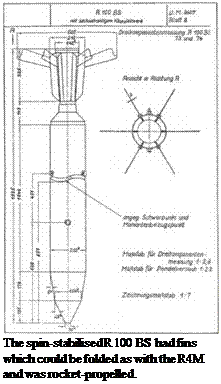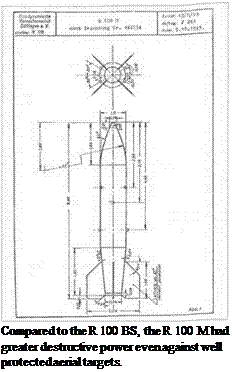R 100 BS and R 100 MS Rockets
 The R 100 air-to-air Rheinmetall-Borsig spin-stabilised rocket was heavier than the WGr 21. Its fragmentation effect was very destructive even against large targets because of the powerful explosive charge. First prototypes capable of Mach 1.5 were developed from 1943 as R 100 M (mine warhead). Several improved versions followed.
The R 100 air-to-air Rheinmetall-Borsig spin-stabilised rocket was heavier than the WGr 21. Its fragmentation effect was very destructive even against large targets because of the powerful explosive charge. First prototypes capable of Mach 1.5 were developed from 1943 as R 100 M (mine warhead). Several improved versions followed.
The projectiles were fired from a simple AG 140 device below the ETC 50 which if necessary could be jettisoned. A Neptun rangemeasuring device was installed. Faun and Elfe equipment could be fitted for automatic firing of the rocket. The R 100 was first fired successfully in December 1944 without an explosive charge. In January 1945 500 were ordered for initial tactical tests. Up to five R 100s were to be carried by the Me 262, six by the Me 410 and 16 by the Ar 234, the latter two carrying their load mounted below the wings.
A report from Rheinmetall-Borsig at Berlin – Marienfelde dated 15 January 1945 considered that the RBI00 BS rocket would be very efficient against any Allied aircraft of the time.
It distributed some 400 red-hot splinters per 56 grams of mass over an area of between 115 and 1,000 square metres. The explosive charge was a 1-kg (2.2-lb) shrapnel mine-type explosive. The splinters would pierce the fuel tanks of an aircraft under attack, their heat then igniting the fuel.
An automatic firing-solution computer, ‘Oberon Process’, developed by Arado engineer Kurt Bornemann was used for aiming. In combination with the EZ 42 gyro-reflex sight attacks were also possible in a pursuit curve at angles up to 30 degrees. The first R 100 BS tests took place atTarnewitz test ground in February 1945, but by the month’s end there were too few rockets left for continuation testing in flight.
Tests in a Me 262 A-la (Works No. 111994) using the R 100 BS saw the rocket being condemned as unsafe and not sufficiently advanced for operational use in the spring of 1945. By 3 March tests had come to a standstill because
the rockets supplied to Tarnewitz were incomplete, and work on an improved firing installation had been set back in an air raid on the assembly plant at Berlin-Marienfelde. Once EZ 42 production at Dresden and the manufacture of the FuG 217 Elfe unit fell by the wayside, the entire venture passed into history at the latest during March 1945.There is no record of any further trials before the test centre fell on 2 May.
 In an extensive evaluation of air-to-air rockets produced just before the war’s end, an R 100 fitted with infra-red equipment and an acoustic fuse was reported close to operational readiness but its manufacture was now menaced by the advancing front. Rockets featured in the various weapons systems on which Ober – gruppenfuhrer Kammler set such store. In the end the production of prototypes was modest. Only a few R 100 rockets survived the end phase of the war to be confiscated by British scientific teams in May 1945.
In an extensive evaluation of air-to-air rockets produced just before the war’s end, an R 100 fitted with infra-red equipment and an acoustic fuse was reported close to operational readiness but its manufacture was now menaced by the advancing front. Rockets featured in the various weapons systems on which Ober – gruppenfuhrer Kammler set such store. In the end the production of prototypes was modest. Only a few R 100 rockets survived the end phase of the war to be confiscated by British scientific teams in May 1945.










